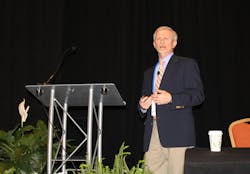Many manufacturers have embarked upon the journey to integrate plant floor systems with enterprise applications, but when there are multiple plants and heterogeneous control architectures involved, it is not an easy task. Just ask Tim Morrison, the global business process manager for production at Dow Corning, who launched a standardization strategy to integrate the company’s industrial control systems (ICS) with enterprise resource planning (ERP).
Dow Corning, which has 24 plants globally housing a mix of control systems, needed to reduce the complexity of its infrastructure as production in manufacturing increased to meet customer demands.
“When the business people want to do something with the customers, the manufacturing floor has to do something to deliver. But the complexity limits our ability to respond,” Morrison said during a presentation at The Automation Conference & Expo this week. “We needed to break the cycle and get rid of the spaghetti chart with a framework that allows the control systems to connect up to SAP [ERP].”
Choosing to standardize on Siemens PCS7 control platform, Morrison also wanted built-in flexibility to integrate with select third-party control systems as well as other applications, such as warehouse management and maintenance. To do that, Dow Corning started with standards, leveraging ISA-88 (for identifying the physical equipment and procedures) and ISA-95 (defining data flow and hierarchy models) in the architecture.
But before starting the integration, Morrison had to get the operations technology (OT) team and the information technology (IT) teams together to document all of the requirements related to the process of exchanging information, as well as security.
“We had the conversation in advance so that everyone’s expectations were the same,” Morrison said. “I can’t stress enough that you need to take the time to do that, otherwise there are misconceptions about what people can do.”
And, then, starting small, the team was able to deliver four key things, including real-time scheduling management from SAP to process orders and into the Siemens’ batch engine. Near real-time material management providing a record of information in the ERP system within a few hours of when it happened. Improved overall equipment effectiveness (OEE), and manufacturing analytics which wrap business context around data captured down at the control system level.
In addition, Morrison advises companies to factor in the physical cybersecurity architecture and think about the future. “Before you head down this path, make sure you secure your journey toward the industrial of internet of things.”
Lessons learned on the Dow Corning journey from ERP to the plant floor and back:
Get the team on the same page early. Get the right experience and expertise in the same room and expand their vision. If OT and IT people learn a little bit about how each work, suddenly good things start to happen.
Scope, scope and scope. It’s a blast to get IT, MES and control people in the same room because they start feeding on each other’s ideas. But a few hours later they are trying to put a guy on Mars. Great ideas, but remember scope.
Manage expectations early. Get IT and OT people on the same page to understand if they are putting the correct architecture in place. The most challenging part of the project is completing the documentation.
Scope – again.
Leaders relevant to this article:

